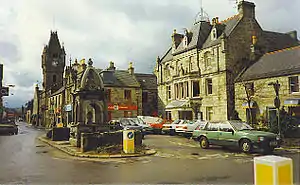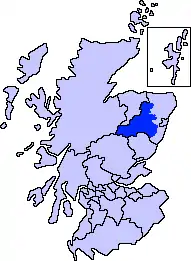Huntly
Huntly (Scottish Gaelic: Srath Bhalgaidh or Hunndaidh) is a town in Aberdeenshire, Scotland, formerly known as Milton of Strathbogie or simply Strathbogie. It had a population of 4,460[2] in 2004 and is the site of Huntly Castle. Its neighbouring settlements include Keith and Rothiemay. Both Huntly and the surrounding district of Gordon are named for a town and family that originated in the Border country.[3]

Huntly
| |
|---|---|
 Gordon Square, Huntly | |
 Huntly Location within Aberdeenshire | |
| Population | 4,810 (mid-2016 est.)[1] |
| OS grid reference | NJ5353 |
| Council area | |
| Country | Scotland |
| Sovereign state | United Kingdom |
| Post town | HUNTLY |
| Postcode district | AB54 |
| Dialling code | 01466 |
| Police | Scotland |
| Fire | Scottish |
| Ambulance | Scottish |
| UK Parliament | |
| Scottish Parliament | |
Huntly is the historic home of the Gordon Highlanders regiment which traditionally recruited throughout the North-East of Scotland.[4] Huntly has a primary school (Gordon Primary) and a secondary school (The Gordon Schools) beside Huntly Castle.
It is the home of the Deans bakers, which produce shortbread biscuits. In November 2007, Deans of Huntly opened their new visitor centre.[5]
There is also a falconry centre just outside the town which does flying displays in their visitor centre during the season between April and October.
Arts
Huntly is home to Deveron Projects, an arts organisation that invites artists from all over the world to come and live and work in the town.[6][7] Since 1995 it has worked with a 'town is the venue' methodology, connecting artists, communities and places.[7][8] It hosts artists and projects that explore local, regional and global topics, such as forestry, geology, botany, foraging, anthropology, history, politics and art. Over 100 renowned artists have spent time in the town, including Roman Signer, Hamish Fulton,[9] and Christine Borland.
Walking is often used as a medium to bring people together for these projects, and Deveron Projects has a Walking Institute that commissions artists to make walks.[6] Their annual Slow Marathon started in 2012 in collaboration with Ethiopian artist Mihret Kebede.[10] Deveron Projects also runs a community kitchen and gardening projects.[11] In 2013 Deveron Projects won Huntly the Creative Place Award, which recognises 'creativity across Scotland’s smaller communities'.[12]
Huntly also has Tin Hut Sessions, which offer open mic folk, blues, and traditional music gigs. Bothy ballads lie at the heart of Huntly and its surrounding areas' traditional music, and musicians Paul Anderson and Shona Donaldson both hail from the town.
Sports
There is salmon and trout fishing on the Rivers Deveron and Bogie, which are administered by the River Deveron Salmon Fisheries Board. Its other principal outdoor activities include golf, Nordic Skiing in Clashindarroch Forest, walking, mountain biking and Rugby. The local football team is Huntly F.C. Nearby is the start point of Scotland's longest horse ride trail, Highland Horseback, which runs 200 miles (320 kilometres) to the West Coast. The Eastern Tigers martial arts have a kickboxing club in Huntly and currently use the Pensioners Hall and the Stewarts Hall. They have produced national and international champions.
History
Settlement around the confluence of the Bogie and Deveron rivers dates back to the Neolithic period. Settlement remains and the remains of an Iron Age hillfort have been excavated on Battlehill on the outskirts of the town. During the first millennium CE the area was dominated by the Pictish culture. A very large Pictish settlement and vitrified hillfort was situated locally at Tap o' Noth in Strathbogie.
The site represented an important strategic site controlling routes from Moray into Strathdon and Deeside. The first motte-and-bailey castle on this settlement was erected by Donchaid McDuff, the gaelic speaking 2nd Mormaer of Fife, c.1180. The lands were transferred to the Berwickshire Anglo-Norman family, the Gordons, in 1352 in retaliation for McDuff’s descendant, David of Strathbogie, defecting from Robert I to Edward I’s cause on the eve of the Battle of Bannockburn.
The settlement at the confluence of the Bogie and the Deveron was known as Milton of Strathbogie or The Raws of Strathbogie until 1508.
Despite the boggy lands in the vicinity at that time, the castle at Strathbogie became a key centre for the Gordons of Moray over the following centuries as the family built power through warfare and dynastic marriage, rising to be the dominant family in the North-East of Scotland – the clan chief acquiring the informal title of Cock o' the North. As a result, a thriving settlement serving the evolving palace complex developed. The settlement became a burgh of barony in 1472. In 1508 the Gordons received a royal charter enabling them to rename Milton of Strathbogie & the castle to Huntly – the name of their ancestral seat in Berwickshire.
During the Scottish Reformation, the Gordons were among the leading Catholic families in the country and heavily embroiled in Mary, Queen of Scots’ conflict with the reformed church and the protestant magnates. Huntly castle was bombarded and sacked in 1562 (by Mary) and in 1594 by James VI.
After the restoration of Gordon titles, the town continued to develop during the 17th and 18th centuries both as a market town and an adjunct to the Gordons’ palace with a wide range of merchants and artisans serving the surrounding countryside – in the mid-17th century the town hosted 4 separate glovers.
The adjacent parishes of Dunbennan and Kinnoir were consolidated into a single parish of Huntly in 1727, though each of these livings had been in the gift of the Marquess of Huntly for centuries. During this century, the Duke of Gordon also commenced redeveloping the town as a planned-town with grid-iron streets.
The 18th centuries saw the development of the flax industry and associated cottage industries in heckling, spinning, bleaching and weaving, though the trade was inhibited in the longer term by poor transport infrastructure to Banff and Aberdeen. Smuggling whisky was also an important trade at this period until the industry was licensed in 1823.
In the 19th century, following the post-Napoleonic slump in the linen trade, the town experienced another period of growth with the establishment of rail transport in 1845 coupled with a shift from peasant farming to capitalist agriculture. Huntly became an important market and shipping centre whilst its surrounding parishes depopulated.
In 1836 the town and the Gordon estates passed to the Sussex-based 5th Duke of Richmond by inheritance. Ownership of the feu and much of the land and property remained in the ownership of the Dukes of Richmond and Gordon until August 1936 when all the property and feus in the town along with much surrounding farmland was sold at auction at Huntly Town Hall in order to pay death duties on the ducal estates.
Though the town’s population has varied slightly over the 20th century – with a net outward migration after the 2nd World War – the town in 2018 had a population of 4,650. This compares with 4,229 in 1911. Significant demographic growth was over the course of the 19th century from 1000 in 1800 to 3,600 in 1861.
Notable people
- Ian Cameron, father of British Prime Minister, David Cameron, was from Glass, Huntly; he was born at Blairmore House.
- Ronald Center (1913–1973), composer, lived there from 1943 until his death in 1973, teaching first at the Gordon Schools, then privately.
- John Henderson (born 1973), a PDC darts player, is from Huntly.
- James Legge (1815–1897), scholar and missionary to China, was born in Huntly and educated there and at King's College Aberdeen, before leaving to his first mission post in Malacca in 1839. Across the next 43 years he worked in Hong Kong translating all the classic books of the Confucian canon in a huge series of books, a set still considered to be the gold standard of English translations today. He frequently returned to Huntly across his life in China, bringing three young Chinese lads to live there and get "a good Scottish education" in 1845. By the time they returned to China in 1848 they had all been invited to meet Queen Victoria, then a lively young woman. Legge retired from his mission work in Hong Kong in 1873, was named the first Oxford Professor of Chinese in 1876, and lived there until his death. His father Ebenezer Legge had been Mayor of Huntly, and the Legge family home is still in use, on the main square.
- George MacDonald (1824–1905), writer, and influence upon JRR Tolkien and CS Lewis. Some of his novels, especially the Robert Falconer and Alec Forbes of Howglen play partly in Huntly, even if the name of the town is changed, and give an introduction to the life in Huntly in the 19th century.
- William Milne (1785–1822), born at Kennethmont near Huntly, was the second British Protestant missionary to China (following Robert Morrison). He was the founding headmaster of the first Anglo-Chinese school, Ying Wa College, in 1818 at Malacca. (This school was subsequently moved to Hong Kong by James Legge in 1843 and still exists.)
- George Philip, (1800–1882) was a cartographer, map publisher and founder of the publishing house George Philip & Son Ltd. He was born in Huntly.
- John Perie (1831–1874) VC, born in Huntly.
- Jo Pitt, para-equestrian (1979-2013), was from Huntly.[13]
- Andrew Young, (born 1992) cross country skier with several world cup podiums.
References
- "Mid-2016 Population Estimates for Settlements and Localities in Scotland". National Records of Scotland. 12 March 2018. Retrieved 30 December 2020.
- "Table 1: Settlements in alphabetical order" (PDF). General Register Office for Scotland. Archived from the original (PDF) on 25 January 2012. Retrieved 5 December 2011.
- Gazetteer of Scotland (1882-5)
- Gordon Highlanders Museum website Archived 2011-09-27 at the Wayback Machine
- "Dean's of Huntly Shortbread". Scotland on TV. Retrieved 5 December 2011.
- Morris, Blake. (2019). Walking Networks : the Development of an Artistic Medium. London: Rowman & Littlefield International. ISBN 978-1-78661-022-5. OCLC 1126214150.
- Sacramento, Nuno. (2010). ARTocracy : art, informal space, and social consequence : a curatorial handbook in collaborative practice. Zeiske, Claudia. Berlin: Jovis. ISBN 978-3-86859-064-7. OCLC 679932663.
- Hristova, Svetlana; Šešić, Milena Dragićević; Duxbury, Nancy (21 April 2015). Culture and Sustainability in European Cities: Imagining Europolis. Routledge. ISBN 978-1-317-67715-4.
- Fulton, Hamish. (2010). Mountain time, human time. Milano: Charta. ISBN 978-88-8158-791-9. OCLC 696737211.
- Morris, Blake (1 January 2018). "The Walking Institute: a reflexive approach to tourism". International Journal of Tourism Cities. 4 (3): 316–329. doi:10.1108/IJTC-11-2017-0060. ISSN 2056-5607.
- Beattie, Kieran. "Deveron Projects in Huntly receives £270,000 from Scottish Land Fund". Press and Journal. Retrieved 5 August 2020.
- "Media Release: 2013 Creative Place award winners announced!". allmediascotland.com. Retrieved 16 July 2020.
- Scots paralympian Jo Pitt dies after lung condition by Natalie Walker, 4 May 2013, accessed 5 May 2013
External links
- Castle Hotel formerly Huntly Lodge, accessed 28 December 2011
- Gazetteer of Scotland (1836) entry for Huntly, accessed 28 December 2011
- Gazetteer of Scotland (1882-5) entry for Huntly, accessed 28 December 2011
- Huntly website.
- Huntly area Portal
- Gordon Primary
- The Gordon Schools
- Falconry Centre
- Sansum Blackbelt Academy
- Deveron Projects Walking Institute
| Wikimedia Commons has media related to Huntly. |

